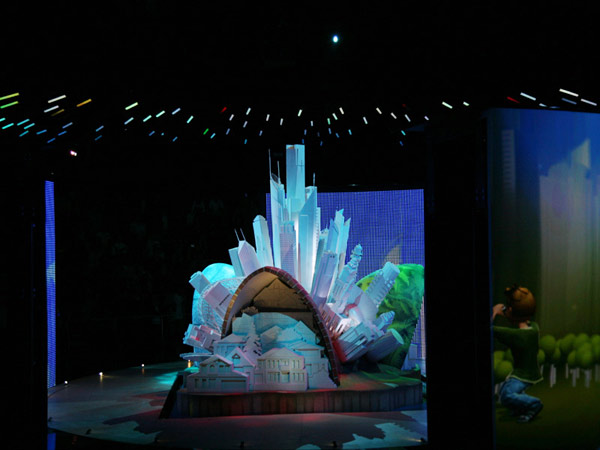Australia Pavilion: city in children's eyes
|
|
|
A 15-minute film depicts the relationship between humans and cities. [CRI] |
The 4,800-square-meter ochre-colored Australia Pavilion, located in Zone B, among other Asian Pacific countries, has an imposing presence. The exterior of the architecture resembles Ayer's Rock, or Uluru, a World Heritage Site and also the "heart" of Australia, guarding the vast outback of the country.
On the first day of its opening, the pavilion extended its hours to 11:00 pm in light of the long queues waiting at the front entrance.
Entering the pavilion, visitors are led onto a path of Australian history and culture sectioned into "Journey," "Discover" and "Enjoy."
During the "Journey," a combination of photos, models, cartoon characters and screens illustrate the formation and growth of the country.
A 1,000-seat circular theatre awaits visitors to "Discover" the true meaning of a city.
Extra-large screens rise from the central stage and spin around slowly in rhythm to the film. In the 15-minute video, the concept is told through the voices of three little children in a playground. From diverse cultural origins, including European immigrant, aboriginal Australian and Chinese descent, the children represent Australia's varied cultural composition.
Innocent and non-preachy, the conversation between the children indicates the idea that humans are seeds while the city is the earth on which we prosper. A primitive ideal expressed through the most advanced technology.
Exiting the theatre, visitors will arrive at the venue for "Enjoy," which is the main hall of the pavilion. With flamboyant flower-shaped lights hanging above, the hall is also the center stage for a series of art performances by Australian artists.
For those who want to bring back some memorabilia, there are also counters selling key chains, stuffed toys and kangaroo-skin purses.
The whole trip will take less than one hour, which for so large a pavilion is a little short. Tan Wei, father from a visiting family of three, who has been to Australia, said there isn't enough to see. "There should be more exhibits or interactive programs that visitors can participate in," Tan said.
But the film in the "Discover" section is worth watching and it is equally educational to adults and children, Tan added.
 0
0 








Go to Forum >>0 Comments